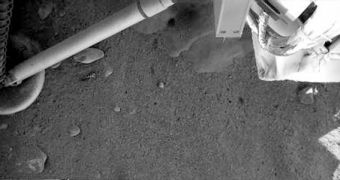The robotic arm of the Phoenix Mars Lander was used yesterday along with the camera attached to it to view the ground beneath the spacecraft and make certain that the soil is clear of any big rocks. The arm has also touched the ground of the landing area for the first time while one of the instruments carried on board by Phoenix experienced a minor short circuit.
Since the stereo camera of the lander sits atop the deck, it is unable to move in position to view under it, therefore the robotic arm of the spacecraft had to be maneuvered into position to get a better look. According to Ray Arvidson from the Washington University, one of the co-investigators for the robotic arm experiment, the images from underneath Phoenix reveal some interesting tabulator formations, whose nature hasn't been identified so far.
"We don't know what they are. They could be exposures of ice, or they could be exposures of rocks. We're really pushing for ice, but we don't know if that's the case yet," said Arvidson yesterday in the briefing that took place at the University of Arizona.
Phoenix's mission is to use its robotic arm and dig the soil in order to pick up samples, which will be later examined by the instruments on board and establish whether or not they contain water ice which may have been once liquid, a tell tale sign that Mars' clime could have once been habitable for microbial life.
The Thermal and Evolved-Gas Analyzer, one of the instruments designed to heat up soil samples delivered by the robotic arm and analyze the vapor content, suffered a short circuit to the heating filament which has the role of ionizing the vapors before being sent to the detectors, however since the instrument has a redundant filament it may still be able to complete its tasks, said William Boynton from the University of Arizona, co-investigator for the TEGA instrument. A diagnostic coming up in the next days should reveal whether or not the instrument is able to operate with a single filament.
"We're quite optimistic that we have a workaround that will let us operate the instrument," said Boynton.
The next task in the series of preparations anticipating the digging operation scheduled to start next week is to use the camera attached to the robotic arm to picture the footpads of the spacecraft and make sure that they sit stable on the ground, while mission scientists are trying to learn as much as possible about the soil before Phoenix takes its first scoop.
Then, the mission scientists will perform a 'soil tough' experiment by making a dent in the soil with the help of the robotic arm and picture the respective area, to ensure that the controllers know how to reach the soil. This will involve a 'dig and dump' maneuver, in which the robotic arm takes a scoop of soil and then dumps the sample. The site of the experiment is still to be chosen, since the data relayed back on Friday night have not been yet analyzed.

 14 DAY TRIAL //
14 DAY TRIAL //